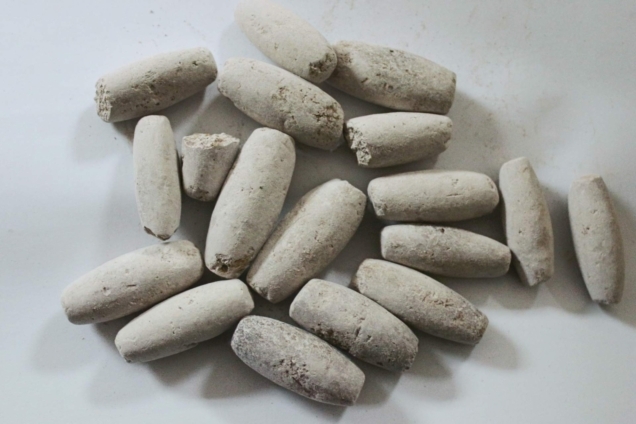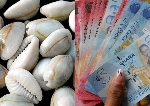Ayilo: Lowers cholesterol, stops the growth of cancer cells
 Ayilo cures cancer
Ayilo cures cancer
Pica is an eating disorder in which a person eats things not usually considered food. One of the most known Pica’s is ayilo.
Ayilo, also known as ayilor by the Ga-Dangmes, is a Ghanaian term for kaolin or bentonite clay. It is a baked solid white clay usually taken by pregnant women.
They are usually baked into egg-shaped balls.
Ewes call it agatawoe/agatawe, and the Akans call it shirew/shile.
Also, Ayilo is known as mabele in the Democratic Republic of the Congo and Cameroon as calaba. Nsu in Nigeria(https://www.alowafoods.com/products/mabele).
The English name is Kaolin. People sometimes say it is bentonite clay. However, they are in the same family with the same benefits.
But what are the scientific benefits of ayilo? I herein explore in this article.
Science
Ayilo is a neglected ‘gold mine.’ A review of geophagy by Sherman et al.(2011) in 482 people and 297 animals found evidence to suggest the main reason people eat dirt is the possible protection soil might offer against toxins.
However, more research is needed to support this theory. Geophagy means eating dirt as part of a cultural practice, or because other people in the family or community also eat dirt, which differs from pica. In this instance, there’s a clear reason for eating dirt.
On the other hand, Pagophagia, persistent ice eating or cravings for ice, can also be a sign of pica. Pica usually won’t be diagnosed in children, as many children eat dirt when they are young and stop on their own. Pica can co-occur with conditions such as trichotillomania or schizophrenia, but it doesn’t always involve a separate mental health diagnosis.
Diarrhoea, Constipation
One animal study by Callahan GN(2003) reasoned that animals eat dirt or clay when they have diarrhea, stomach distress, or poisonous fruit. Bismuth subsalicylate (Kaopectate), a medication that treats diarrhea, has a mineral makeup that’s similar to kaolin, or the kind of clay some people eat for the same purpose. So eating soil could potentially relieve diarrhea.
Moosavi M(2017) study suggests that clay may help some people with irritable bowel syndrome with constipation by regulating bowel movements. Also, another study by Buccigrossi et al.(2017) found that a type of adsorbent clay called diosmectite helped stop rotavirus from replicating. Littman et al.(2022) reasoned that bentonite can also help to treat diarrhea.
Reduce Morning Sickness
Callahan GN(2003) study found that pregnant women worldwide eat dirt to help ease morning sickness symptoms. This is practiced in most cultures.
Detoxification
Srasra and Bekri-Abbes(2020) review found clay to be a natural detoxifier. A recent study by Wang et al.(2021) found bentonite clay’s effectiveness at aflatoxin sorption in earlier animal and human trials. The researchers also tested a sodium bentonite clay on computational, in vivo, and in vitro models, suggesting it may offer a method to combat emergencies, such as an outbreak of acute aflatoxicosis.
A recent study by Littman et al.(2022) used a combination of bentonite clay, probiotics, and black seed oil to treat a 2-year-old with a Clostridium difficile (C. diff) infection. After four days, there were no traces of C. diff in the child’s stool samples.
Finally, another recent study by Oguz et al.(2022) found that clay is effective when consumed, including bentonite, to bind to various toxins in animal feed depending on the type of toxin.
Diaper Rash
Wang and Phillips(2023) recommend that calcium montmorillonite clay may enhance the antibacterial effect of barrier creams against Escherichia coli formation. The authors highlight that montmorillonite clay may occur in creams to treat diaper rash due to its adsorption properties.
Removing lead and other heavy metals
A recent study by Abdelnaby et al.(2023) recommends that bentonite clay nanoparticles help to remove trace elements of residual lead and cadmium from milk. On the other hand, Moosavi M et al.(2017) review also recommends that bentonite is an effective treatment for metal toxicity in animal models.
Lowers cholesterol
A study by Turgut et al.(2021) recommends the following combinations of ingredients have a cholesterol-lowering effect on mice:
bentonite, grape seed extract, and turmeric bentonite, grape seed extract, psyllium, and turmeric bentonite, grape seed extract, turmeric, and flaxseedStops Growth of Two Cancer Cell Lines in a Lab
Cervini-Silva et al.(2016) study found that eating clay stopped the growth of cancer cell line U251, a human cancer cell found in a central nervous cancer called glioblastoma. However, another cell line grew larger when exposed to the substance.
The researchers explained that the cell formations and swelling of bentonite clay are the reasons for this, and it could potentially be effective against specific types of cancers (like glioblastomas) but not others.
Another lab experiment by Maisanaba et al.(2014) found clay to cause cell death of Caco-2 cells, a colorectal cancer line. In this study, the clay exhibited a large amount of oxidative stress upon just the cancer cells without damaging the DNA.
Supports thyroid function
One study by Cai et al.(2006) in mice studies, found clay to absorb certain thyroid hormones (T3 and T4), resulting in the alleviation of hyperthyroidism. This result suggests bentonite might potentially help people keep thyroid levels down, although the test has not been duplicated in humans as of yet.
Supports Weight Loss
Xu et al.(2016) trial in rats tested the impact of clay on weight loss and found that the supplement was correlated with weight loss, as well as decreased cholesterol.
Kaolin v Bentonite
Bentonite clay, also known as calcium bentonite clay, comes from volcanic ash and is manufactured mainly in the United States. Its name comes from the primary bentonite clay producer in the U.S., volcano-rich Fort Benton, Montana.
Bentonite clay is cost-effective, although it is far more intense for the skin than kaolin clay. However, bentonite clay has a much higher pH level than kaolin clay.
Kaolin clay is a mild type of clay made up of a mineral known as kaolinite, which can be found all over the globe. You may also see it referred to as white clay.
The original kaolin clay was harvested from a hill in China, Kao-ling, which was the only source of the clay for hundreds of years.
Kaolin clay is known for being very finely powdered, soft, and usually off-white or pink.
The clay is composed of tiny minerals and crystals (including feldspar, quartz, silica, copper, magnesium, and zinc). It has a relatively neutral pH level of around 4.5, which is close to the skin’s natural pH of 5.5, and bentonite clay sits at around 8.5. This makes it slightly more “basic” on the pH scale, which can help people open their pores even further to accept more products.
Although deciding which clay to use comes down to your personal skin care needs, however, kaolin clay(ayilo) is more beneficial. Why? kaolin clay is more gentle and accessible for all skin types, so you don’t need to worry about how your skin may react.
Warning
In 2016, the FDA warned consumers not to use a certain type of bentonite clay due to its high lead levels.
A study by Steiner-Asiedu et al.(2016)assessed the microbial quality of clay samples sold in two of the major Ghanaian markets. They concluded that ayilo samples were found to contain Klebsiella spp. Escherichia, Enterobacter, Shigella spp. staphylococcus spp., yeast, and mold. These have health implications when consumed.
Another study by Kotei et al.(2019) showed that there are beneficial minerals in ayilo, however, the accumulated effects of these heavy metals can lead to various complications in pregnancy.
The clay also contained pathogenic microorganisms. Traces of Lead, Nickel, and Arsenic were found in the clay. Common microorganisms identified were Bacillus, Pseudomonas, Mucor , and Aspergillus spp.
A recent study by Konlan et al.(2020) examined the use of ayilo amongst pregnant women and found that, out of the 286 pregnant women, 21.2% and 17.8% considered white clay and ice respectively as nutritious.
Prevalence was 47.5%, while 44.9% of pregnant women reported they feel uncomfortable when they do not eat ayilo, and 63.3% considered intake as harmful. Among women who received education against ayilo practice, 49.4% have ever taken it and 50.9% of them with education on effects were currently engaged in the activity.
Also, a study by Moosavi M(2017) found that eating clay causes side effects when a person uses large amounts.
Sherman et al. (2011) also reported that eating clay could have an effect on nutrients, since clay in the stomach may bind to iron, zinc, and other nutrients. In other words, eating dirt could increase the risk of anemia.
The high potassium in clay could lead to high blood potassium, increasing your risk for cardiac arrhythmia or cardiac arrest. Constipation is also expected when one eats more clay.
It can also alter the immune function, though, a study in animal by Cindy Engel(2007) have suggested clay consumption offers protection against a range of toxins.
Recommendation & Conclusion
Drink plenty of water throughout the day while using ayilo.
This will help flush the clay from the digestive tract and prevent constipation.
Also, ayilo is an ancient remedy that could hold promise as a treatment for various health conditions. It has a low risk of side effects when a person uses it in moderate amounts.
There is a need to tap into ayilo-related products.
I recommend that the government should tap into the ayilo industry.
This could generate millions of dollars to the national coffers.
The writer is a Professor of Naturopathic Healthcare, a Medical Journalist, an author, and a science writer. E. mail: [email protected]. For more about me, Visit: profnyarkotey.com
References
Steiner-Asiedu M, Harrison OA, Vuvor F, Tano-Debrah K. Quality evaluation of processed clay soil samples. Pan Afr Med J. 2016 Jun 6;24:118. doi: 10.11604/pamj.2016.24.118.8406. PMID: 27642456; PMCID: PMC5012739. Kortei NK, Annor IA, Aboagye G, Manaphraim NYB, Koryo-Dabrah A, Awude E, Essuman EK, Alidu HW, Tettey CO, Awadzi B. Elemental minerals and microbial compositions as well as knowledge and perceptions regarding kaolin (clay) consumption by pregnant women in the Ho municipality of Ghana. Pan Afr Med J. 2019 Oct 28;34:113. doi: 10.11604/pamj.2019.34.113.17394. PMID: 31998429; PMCID: PMC6961938. Konlan KD, Abdulai JA, Konlan KD, Amoah RM, Doat AR. Practices of pica among pregnant women in a tertiary healthcare facility in Ghana. Nurs Open. 2020 Jan 28;7(3):783-792. doi: 10.1002/nop2.451. PMID: 32257266; PMCID: PMC7113508 Moosavi M. Bentonite Clay as a Natural Remedy: A Brief Review. Iran J Public Health. 2017 Sep;46(9):1176-1183. PMID: 29026782; PMCID: PMC5632318. Callahan GN. Eating dirt. Emerg Infect Dis. 2003 Aug;9(8):1016-21. doi: 10.3201/eid0908.ad0908. PMID: 12971372; PMCID: PMC3020602. Wang M, Hearon SE, Phillips TD. A high capacity bentonite clay for the sorption of aflatoxins. Food Addit Contam Part A Chem Anal Control Expo Risk Assess. 2020 Feb;37(2):332-341. doi: 10.1080/19440049.2019.1662493. Epub 2019 Dec 2. PMID: 31790632; PMCID: PMC6989347. Srasra E, Bekri-Abbes I. Bentonite Clays for Therapeutic Purposes and Biomaterial Design. Curr Pharm Des. 2020;26(6):642-649. doi: 10.2174/1381612826666200203144034. PMID: 32013819. Oguz H, Bahcivan E, Erdogan T, Yalcin NF, Ozdas A, Isık MK, Altunbas O. In vitro mycotoxin binding capacities of clays, glucomannan and their combinations. Toxicon. 2022 Jul 30;214:93-103. doi: 10.1016/j.toxicon.2022.05.006. Epub 2022 May 18. PMID: 35597522. Moosavi M. Bentonite Clay as a Natural Remedy: A Brief Review. Iran J Public Health. 2017 Sep;46(9):1176-1183. PMID: 29026782; PMCID: PMC5632318. Wang M, Phillips TD. Lecithin-amended montmorillonite clays enhance the antibacterial effect of barrier creams. Colloids Surf B Biointerfaces. 2023 Sep;229:113450. doi: 10.1016/j.colsurfb.2023.113450. Epub 2023 Jul 10. PMID: 37451226; PMCID: PMC10528371. Abdelnaby A, Abdelaleem NM, Elshewy E, Mansour AH, Ibrahim SS. Application of Bentonite Clay, Date Pit, and Chitosan Nanoparticles as Promising Adsorbents to Sequester Toxic Lead and Cadmium from Milk. Biol Trace Elem Res. 2023 May;201(5):2650-2664. doi: 10.1007/s12011-022-03353-w. Epub 2022 Jul 13. PMID: 35829983; PMCID: PMC10020323. Turgut R, Kartal M, Akkol EK, Demirbolat İ, Taştan H. Development of Cholesterol-Lowering and Detox Formulations Using Bentonite and Herbal Ingredients. Front Pharmacol. 2021 Dec 6;12:775789. doi: 10.3389/fphar.2021.775789. PMID: 34938189; PMCID: PMC8685422. Cervini-Silva J, Ramírez-Apan MT, Kaufhold S, Ufer K, Palacios E, Montoya A. Role of bentonite clays on cell growth. Chemosphere. 2016 Apr;149:57-61. doi: 10.1016/j.chemosphere.2016.01.077. Epub 2016 Feb 3. PMID: 26849195 Maisanaba S, Gutiérrez-Praena D, Pichardo S, Moreno FJ, Jordá M, Cameán AM, Aucejo S, Jos A. Toxic effects of a modified montmorillonite clay on the human intestinal cell line Caco-2. J Appl Toxicol. 2014 Jun;34(6):714-25. doi: 10.1002/jat.2945. Epub 2013 Oct 9. PMID: 24122917. Xu P, Dai S, Wang J, Zhang J, Liu J, Wang F, Zhai Y. Preventive obesity agent montmorillonite adsorbs dietary lipids and enhances lipid excretion from the digestive tract. Sci Rep. 2016 Feb 19;6:19659. doi: 10.1038/srep19659. PMID: 26891902; PMCID: PMC4759552Source: Prof Rapheal Nyarkotey Obu
Trending Features

British-Ghanaian lawyer Bianca Akweley Clinton marks 20 years at the Bar
19:02
The death of critical thinking and the rise of collective stupidity as an existential threat
08:32
Cybersecurity and Constitutional Order: Why ILAPI calls for redress before Ghana’s Cybersecurity (Amendment) Bill becomes law
23:32
Cedi at 60: What you need to know about Ghana’s legal tender
15:04
From shells to screens: Experience 60 years of the Ghana cedi in augmented reality
10:38
Hair, discipline, and identity: The debate over SHS haircut rules in Ghana
10:07
Tribute to Nana Konadu Agyeman-Rawlings
13:07
Leveraging Analytics to Optimise Ghana’s Energy Grid
12:29
Ending child marriage — Beyond hashtags and promises
11:42
Breaking the silence: How social media is transforming the fight against sexual and domestic violence
10:04




